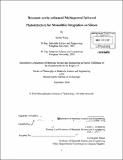| dc.contributor.advisor | Lionel C. Kimerling. | en_US |
| dc.contributor.author | Wang, Jianfei, Ph. D. Massachusetts Institute of Technology | en_US |
| dc.contributor.other | Massachusetts Institute of Technology. Dept. of Materials Science and Engineering. | en_US |
| dc.date.accessioned | 2011-05-09T15:19:09Z | |
| dc.date.available | 2011-05-09T15:19:09Z | |
| dc.date.copyright | 2010 | en_US |
| dc.date.issued | 2010 | en_US |
| dc.identifier.uri | http://hdl.handle.net/1721.1/62682 | |
| dc.description | Thesis (Ph. D.)--Massachusetts Institute of Technology, Dept. of Materials Science and Engineering, 2010. | en_US |
| dc.description | Cataloged from PDF version of thesis. | en_US |
| dc.description | Includes bibliographical references (p. 162-172). | en_US |
| dc.description.abstract | Multispectral infrared (IR) detection has been widely employed for numerous applications including hyperspectral imaging, IR spectroscopy, and target identification. Traditional multispectral detection technology is based on the combination of broadband focal plane arrays (FPA) and spectral filters, grating spectrometers, or Fourier transform spectrometers, which requires bulky, high-cost mechanical scanning instruments and have a slow response. Hybrid structures integrating FPA and silicon readout integrated circuits (Si ROIC) greatly limit the yield and result in extremely expensive devices. Single photodetectors capable of detecting multiple wavebands simultaneously and monolithic integration with Si ROIC, however, enable dramatically simplified system design with superior mechanical robustness, and thus attract a lot of interest around the world today. In this thesis, we focus on the development of novel IR sensitive material and resonant-cavity- enhanced (RCE) photodetector devices that address the emerging need in the field of IR radiation detection. Polycrystalline PbTe films have been identified as the IR absorbing layers due to their high photosensitivity and fabrication flexibility; on the device side, we have established a universal design theory for multispectral detection and demonstrated fully functional mid-IR RCE photodetectors capable of monolithic integration with Si ROIC. We have developed room-temperature-sensitized, polycrystalline PbTe films using single source thermal evaporation for detecting IR light up to 5 pm in wavelength. Thinner PbTe layers yields enhanced performance than thicker layers due to strong thickness dependence of both photo-responsivity and detectivity. Structural, electrical, and optical property studies reveal photoconductivity mechanism in the films and point out directions of further material optimization. We have established a versatile and scalable design theory for cavity-enhanced multispectral photodetectors using phase-tuned propagation. Critical coupling condition is identified as the prerequisite to achieve near unity quantum efficiency in RCE photodetectors. Coupling-matching layers are positioned between cascaded planar resonant cavities for controlling optical phase and coupling strength between incident light and resonant modes to obtain critical coupling condition. After developing another two IR transparent layers as low and high index materials, evaporated As2S3 and sputtered Ge, we design and fabricate distributed Bragg reflectors (DBR) for mid-IR resonant cavities. In our design example of dual waveband RCE photodetectors, peak quantum efficiencies over 80% have been realized in both wavebands (1.55 pm and 3.6 pm) with only 50 nm and 100 nm thick PbTe IR absorbers, and spectral cross talk as low as 0.1% is obtained. Preliminary results on our first attempt of fabricated dual waveband RCE photodetectors demonstrate the two resonant cavity modes at 1.61 pm and 3.70 pm. And quantum efficiencies as high as 92% and 68% have been achieved in two wavebands respectively. We have developed and optimized a multi-step lift-off patterning technique to fabricate RCE photodetectors on a Si platform. Single waveband RCE photodetectors for mid-IR (3.5 pm) have been designed according to critical coupling condition to achieve near unity quantum efficiency. The fabricated devices show high quantum efficiency (90%) and peak responsivity at the resonant wavelength of 3.5 pm, which is 13.4 times higher than blanket PbTe film of the same thickness. We demonstrate detectivity as high as 0.72x0 cmHzmW~l, comparable with commercial polycrystalline mid-IR photodetectors. As low temperature processing (150 'C) is accomplished in the entire fabrication process, this demonstration paves the way for monolithic integration of RCE photodetectors with Si ROIC. Lastly, for the first time, we fabricate and test integrated devices of single waveband (3.6 pm) RCE photodetectors and Si ROIC. Both hybrid and monolithic integration structures are investigated. We have developed the fabrication process to accommodate Si ROIC chips of only 3 mm x 5 mm in area, and successfully integrated RCE photodetectors on Si ROIC directly. Our preliminary results show high promise for monolithic integration of RCE photodetectors and Si ROIC in the future. | en_US |
| dc.description.statementofresponsibility | by Jianfei Wang. | en_US |
| dc.format.extent | 172 p. | en_US |
| dc.language.iso | eng | en_US |
| dc.publisher | Massachusetts Institute of Technology | en_US |
| dc.rights | M.I.T. theses are protected by
copyright. They may be viewed from this source for any purpose, but
reproduction or distribution in any format is prohibited without written
permission. See provided URL for inquiries about permission. | en_US |
| dc.rights.uri | http://dspace.mit.edu/handle/1721.1/7582 | en_US |
| dc.subject | Materials Science and Engineering. | en_US |
| dc.title | Resonant-cavity-enhanced multispectral infrared photodetectors for monolithic integration on silicon | en_US |
| dc.type | Thesis | en_US |
| dc.description.degree | Ph.D. | en_US |
| dc.contributor.department | Massachusetts Institute of Technology. Department of Materials Science and Engineering | |
| dc.identifier.oclc | 714363470 | en_US |
